Amanita aprica Unveiled
Sierran “Mystery Amanita” finds a new name
Spring and early summer is a wonderful time to visit the mountains of California, especially if you are a mushroomer! When the ground starts to dry up along the coast, we can usually still count on a few snow-melt fungi at elevation, as well as various mountain mushrooms popped by always welcome spring rains. Along with red and orange, yellow and white Amanita muscaria, and fat and delicious, yellow or white spring Coccora, another curious, gemmata-like yellow-capped amanita can also be found under those mountain conifers, the newly described Amanita aprica.
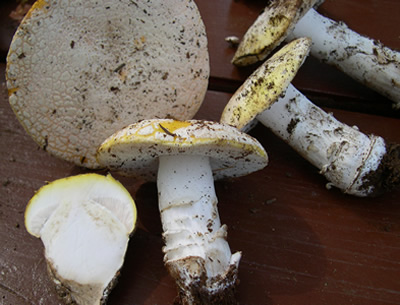
Amanita aprica collection from Round Valley Lake, CA
In the 1986 second edition of "Mushrooms Demystified," author David Arora called this mushroom "a vernal mountain form" of gemmata "that may actually be a distinct species." It is a curious mushroom that shares attributes with both muscaria and gemmata: a volva that can either be cupped or ringed, a brilliant yellow to orange cap, and an annulus or skirt (that is often lost).
Rod Tulloss and Jan Lindgren formally named this species Amanita aprica in Mycotaxon in 2005. Aprica or the "Sunshine Amanita" (so called because it prefers to fruit in exposed areas) hails from the Pacific Northwest and the Sierra. I can't help but think of "aprica" as also referring to its sometimes apricot color. The very first specimen that I ever saw (although I didn’t know what it was at the time) was colored apricot-orange. However, that color morph seems to be fairly rare. Most of the aprica that I have seen or collected since have had caps with a brilliant, almost "day-glo" intensity yellow.
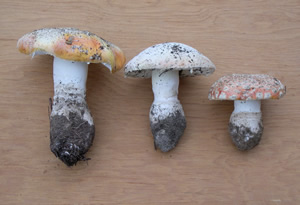 |
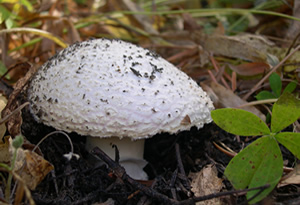 |
| Sierran Amanita aprica collection | Aprica in situ |
Another unique aspect to this species is that the universal veil tissue that covers the cap, forming low warts, actually grows into the cap tissue itself. This can create a curious bloom or frost on the cap surface as the cap expands: a whitish film that cannot be readily removed. In contrast, both the true Amanita gemmata and yellow A. muscaria have warts that can be readily scraped from the cap surface.
Amanita aprica has intrigued Sierra mushroom collectors for years with its peculiar blend of morphological features… and arguments over whether it was just an odd morph of gemmata or something truly different have now been put to rest. It’s not a weird gemmata at all, but a perfectly normal Amanita aprica!
According to Rod Tulloss, this mushroom is seriously toxic, producing very unpleasant effects in those foolish enough to eat it. The symptoms (nausea, vomiting, cramps, muscle spasms, diarrhea, hallucinations, and drowsiness) are similar to ibotenic acid poisoning (the primary toxin found in Amanita muscaria and A. pantherina) but may also be due to a toxin unique to aprica and the closely related gemmata-esque amanitas.
For your edification and amusement, here is a bit of illustrative history on the identification of this mushroom from my field notebooks, in the years just prior to its official description and publication. Enjoy this stroll down "I can’t believe this one is a gemmata!!!" memory lane.
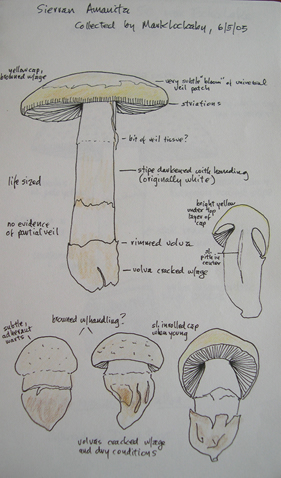 |
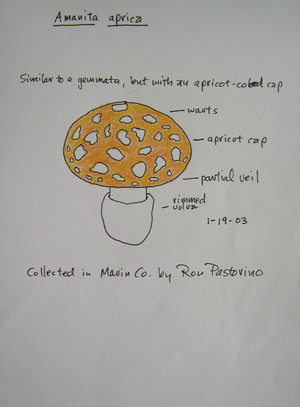 Aprica? Identification pending |
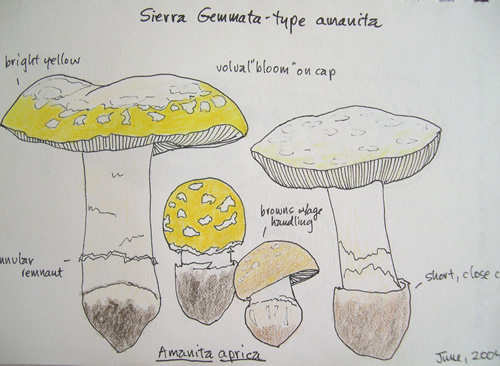
Drawing by Debbie Viess
Enjoy this mushroom for its unusual taxonomic history, or as a striking subject for sketches or photographs, and leave those kitchen forays for species more suited to the table, like morels, spring king boletes, or even the spring coccora (but only if you are experienced enough to safely collect and ID it).
You can be sure that there will be even more new names and mycological concepts coming our way, solving old taxonomic riddles and sometimes, creating new ones in their stead.
© Debbie Viess

 back to top
back to top